By: Byron Mathioudakis
They may have slipped underneath your radar, but electrified utes are already amongst us.
The BYD Shark plug-in hybrid ute is in our midst, and the LDV eT60 fully electric ute has been on sale for around two years.
Electrification has also begun to appear in mainstream brands, with Toyota launching a 48-volt mild hybrid system to the Hilux ute in mid-2024.
More are coming too, prompted by the New Vehicle Efficiency Standard (NVES), which requires manufacturers to produce lower-emissions vehicles and/or offset the emissions of their current models.
What’s electrified right now? Who’s next? And who’s sitting it all out? Let’s dive in.
RELATED:
- Best Electric Cars coming to Australia in 2025 »
- Electric Cars available in Australia »
- Electric SUVs available in Australia »
- Electric Vans available in Australia »
- Small Electric Cars available in Australia »
LDV eT60 ute from $92,990
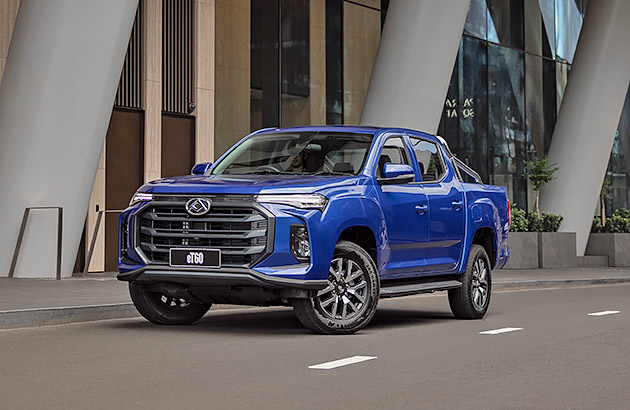
Here’s a bit of Australian automotive history in the making. The LDV eT60 is the first EV ute ever sold here.
It’s essentially a T60 Max double cab but with the diesel engine removed and an electric motor mounted on the rear axle, along with a sizeable 88.5kWh battery, for a useful WLTP-rated 325km of range.
A 50kW public DC charger should see a 20-80 per cent top-up in about 90 minutes, a 7kW Wallbox needs about 15 hours for a 100 per cent recharge, while a normal home socket could take up to 50 hours.
Drawbacks include the lack of four-wheel drive, since that rear-mounted electric motor can only drive the rear wheels; reduced towing capacity of just 1000kg – that’s a far cry from the 3500kg that many rival diesel utes manage; and poor range when laden. Its retail price is also unrealistic for most buyers - $92,990 plus on-roads – though there has been discounting available more recently.
LDV’s next-generation EV truck, expected later in 2025, promises to be much better.
| Motor: | Synchronous electric permanent-magnet |
|---|---|
| Transmission/drive: | Single-speed reduction gear/RWD |
| Battery: | 88.5kWh Lithium Ion |
| Power/torque: | 130kW/310Nm |
| 0-100km/h: | 18.4 |
| Consumption: | 26.8kWh/100km |
| Electric range: | 330km |
| Warranty: | 5yr/160,000km |
| Battery warranty: | 8yr/160,000km |
| Payload: | 1000kg |
| Towing capacity: | 1000kg (braked) |
| Safety rating: | N/A |
Tembo Tusker from $82,000
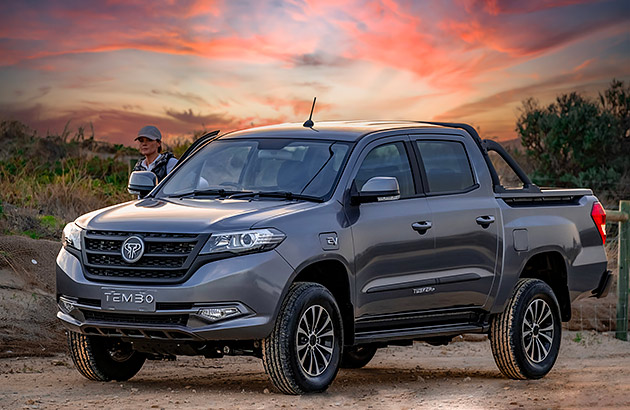
Founded in the Netherlands, Tembo has been converting existing EV utes in Australia since 2018.
Aimed at the mining rather than the private sector, the Tusker is its first full-vehicle import. It appears to be based on the Chinese-market Foday Lion F22.
The Sydney-based company says it will bring 200 examples to Australia and New Zealand by the end of 2026, and already has several dozen orders in hand.
Two Tusker models are available – the single-cab, rear-motor, rear-wheel-drive ‘S’ workhorse, and the more-luxurious dual-cab, dual-motor, four-wheel drive ‘D’. Prices kick off from around $82,000 before on-road costs.
Among other features, Tembo says it employs double wishbone independent suspension for extra comfort.
Note that the 1000kg payload/3000kg braked towing capacity has yet to be homologated for Australia.
| Motor: |
Electric single-motor RWD (S), 4WD (D) |
|---|---|
| Battery: | 66kWh (S), 77kWh (D), Lithium Iron Phosphate |
| Power/torque: | 120kW/330Nm (S), 130kW/330Nm (D) |
| 0-100km/h: | 18.4 |
| Consumption: | 26.8kWh/100km |
| Electric range: | N/A |
| Payload: | 1000kg |
| Towing capacity: | 3000kg |
| Safety rating: | N/A |
Electric utes coming soon
LDV e-Terron 9
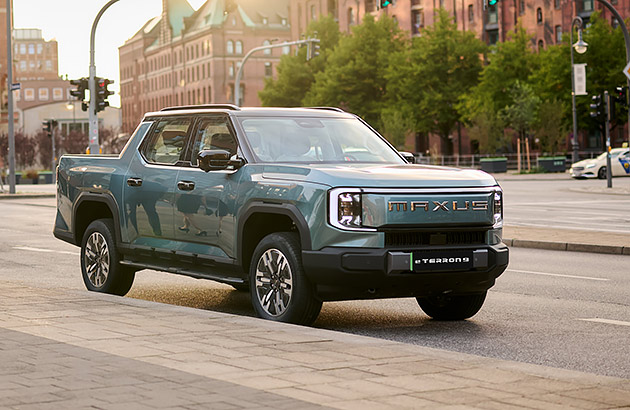
LDV might be first again, this time with Australia’s first four-wheel drive electric ute.
Like the preceding eT60 that may continue on, the all-new e-Terron 9 might also offer ICE versions as well.
Considerably larger than a Toyota HiLux, the chunky LDV scores an electric motor on each axle (125kW/front, 200kW/rear) for four-wheel drive, for exceptional performance, and also offers bi-directional charging.
The dual-cab body is semi-monocoque, rather than body-on-frame construction, for added rigidity and refinement. Under the bonnet is a massive storage space.
The screen-heavy interior looks ultra-contemporary, there’s available air suspension for dramatically improved comfort, while superior charging and range capabilities are further advancements.
Naming for Australia should be announced closer to its 2025 local launch. Pricing may exceed $100,000.
| Motor: | Electric, dual motor, 4WD |
|---|---|
| Battery: | 102kWh Lithium Ion |
| Power/torque: | 325kW/---Nm |
| 0-100km/h: | 5.8 seconds |
| Consumption: | N/A |
| Electric range: | 430km |
| Payload: | 580kg |
| Towing capacity: | 3500kg |
| Safety rating: | N/A |
Electric utes on the horizon
Isuzu D-Max EV
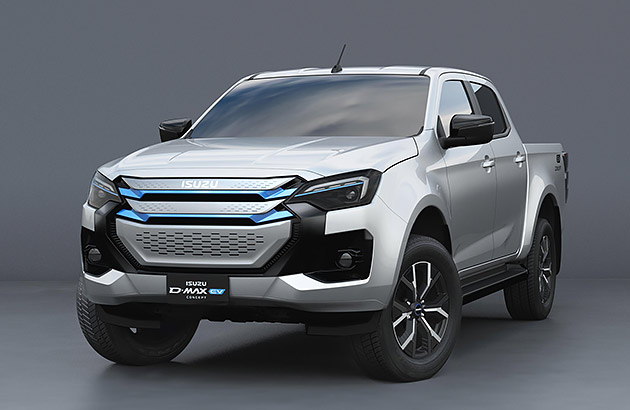
Isuzu could beat the big-name players with its Battery Electric Vehicle (BEV) version of its popular D-Max.
Launching in Europe first during 2025, the dual-cab EV could make it to Australia not long after that, though the Japanese ute veteran says due diligence to assess demand and infrastructure is required here before taking this big step.
Isuzu knows the Australian buyer, having supplied us with the Holden Rodeo (later as the Colorado) since the 1970s and the D-Max since the late 2000s.
Previewed as a concept car back in March 2024, the EV ute ditches the diesel engine for an electric motor on each axle (40kW up front, 90kW out back) for four-wheel drive, along with a centrally mounted battery.
But don’t worry, D-Max fans: a ladder-frame chassis construction and full four-wheel drive capability is included, along with no reductions in braked-towing and one-tonne payload capacities. Isuzu is doing the EV ute thing right.
| Motor: | Electric, dual motor, 4WD |
|---|---|
| Battery: | 66.9kWh Lithium Ion |
| Power/torque: |
130kW/325Nm |
| 0-100km/h: | N/A |
| Consumption: | N/A |
| Electric range: | 300km |
| Payload: | 1000kg |
| Towing capacity: | 3500kg (braked) |
| Safety rating: | N/A |
KGM SsangYong O100
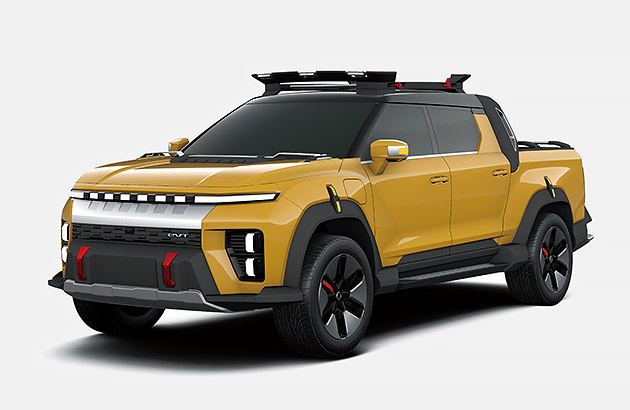
KG Mobility (KGM) bought out troubled SsangYong in 2022, and is now reinvigorating the line-up.
Unveiled as the O100 Concept, and pencilled in for 2025 production, nothing has been confirmed for Australia as yet, but a UK launch next year suggests we are not too far behind.
Size-wise, the O100 is smaller than a Ford Ranger, being essentially a dual-cab coupe-utility version of the Toyota RAV-sized Torres EVX SUV. This means it offers monocoque construction rather than heavy body-on-frame construction, for increased efficiency and range.
Speaking of which, China’s BYD is supplying the dual electric motor powertrain for four-wheel drive, with the front-axle mounted one doing most of the driving.
KGM says it is aimed at “urban drivers” who need the practicality and capability of an open-bed ute, and offers vehicle-to-load (V2L) ability to power electrical tools.
More information will come when the production version of this sub-SsangYong Musso EV ute is revealed soon.
Specifications for this vehicle were not available at the time of publication.
Geely Radar RD6
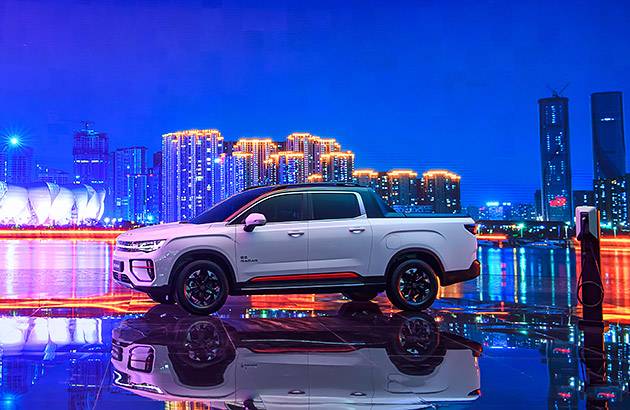
Geely, the Chinese owner of the Volvo, Polestar, Lotus and Zeekr brands amongst others, is expected to release the Radar RD6 in Australia sometime in the near future.
Like the KGM SsangYong O100 Concept, this is a monocoque-bodied dual-cab ute in the name of lightness and efficiency, but is almost full-sized dimensionally. It also rides on car-like suspension – struts up the front and a multi-link independent arrangement out the back.
Measuring in at nearly 5.3 metres long, 1.9m wide and nearly 1.9m tall, it is a roomy five-seater. Better still, it has a load bed longer than the Ford Ranger’s, though it’s not as wide.
Two versions are available abroad: a single-motor rear-drive and dual-motor four-wheel drive, with two battery choices. Geely says a high-powered DC charger can replenish the smaller battery from 30-80 per cent charge in about half an hour.
Geely reckons the Radar’s electric powertrain has undergone over one million kilometres of development.
| Motor: | Electric, single-motor RWD, dual-motor 4WD |
|---|---|
| Battery: | 63kWh or 86kWh nickel-cobalt-manganese |
| Power/torque: |
200kW/384Nm (RWD), 315kW/594Nm (4WD) |
| 0-100km/h: | 7.3s |
| Consumption: | N/A |
| Electric range: | 320-440km |
| Payload: | 755kg |
| Towing capacity: | 2500kg |
| Safety rating: | N/A |
JAC T9 EV
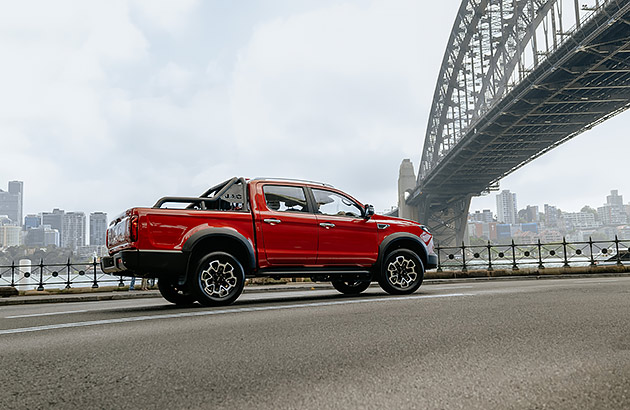
After a decade’s absence, the Chinese brand returned with the T9 diesel during mid-2024, but is planning an EV assault on rivals as well.
No confirmation as to when Australian sales will begin as yet, but the model in question can be differentiated from its ICE counterpart by its more-aero grille and wheels.
Based on the existing T9 ute generation unveiled in China in 2020 and facelifted in 2023, the EV version uses two electric motors, one on each axle, driving all four wheels. An LFP battery offers 340km of WLTP range, while top speed is 140km/h.
Load area wise, the T9 is right up there with the Ford Ranger and Toyota HiLux, while the interior is also roomy enough for five.
Eyeing off the BYD Shark 6 PHEV, JAC is also contemplating a PHEV version, with a turbo-petrol engine and a somewhat smaller battery than its EV sibling.
| Motor: | Electric, dual-motor 4WD |
|---|---|
| Battery: | 88kWh Lithium Iron Phosphate |
| Power/torque: |
230kW/518Nm |
| 0-100km/h: | 8.5s |
| Consumption: | 26.7kWh/100km |
| Electric range: | 330km |
| Payload: | 835kg |
| Towing capacity: | 2000kg |
| Safety rating: | N/A |
Foton Tunland G7 EV
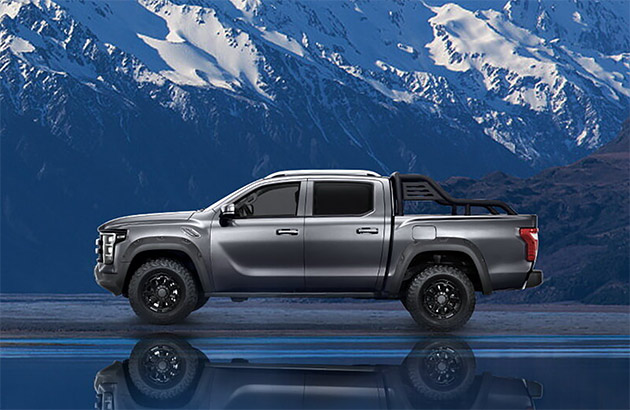
Subaru importer Inchcape will reintroduce Foton to Australia during 2025, after a six-year absence, with the Tunland V7 and V9 dual-cab utes.
Larger than a Ford Ranger, these are about the size of the GWM Cannon Alpha also from China. All will be diesel-powered initially, though electrification models are being planned.
Of most interest is the G7 EV, also under investigation for Australia, to take on the LDV, Geely and Tembo alternatives. If it gets the green light, sales could start from about 2026.
Details are scant, but it is understood that a rear-axle mounted electric motor will drive the rear wheels only, though a dual-motor four-wheel drive version might be in the pipeline for later on.
Employing a variation of the V9 dual-cab’s architecture, reports suggest that the G7 EV offers over 1000kg of payload and about 3000kg of braked towing capacity.
| Motor: | Electric, single-motor RWD |
|---|---|
| Battery: | N/A |
| Power/torque: |
130kW/330Nm |
| 0-100km/h: | N/A |
| Consumption: | N/A |
| Electric range: | 400km |
| Payload: | 1090kg |
| Towing capacity: | 3000kg |
| Safety rating: | N/A |
Plug-in hybrid electric utes
As a stepping stone from HEVs to EVs, PHEVs occupy an increasingly important place amongst new-car buyers.
Their main advantage is no range anxiety: if the moderate-sized battery runs low and you’re unable to reach a charger, the ICE will start to replenish the battery. It can also add extra muscle if required.
Downsides? There’s extra weight with two powertrains and more complexity to go wrong down the track.
Still, as a part-time EV and part-time ICE vehicle, a PHEV can be the best of both worlds.
Plug-in hybrid electric utes here now
BYD Shark 6 from $59,900 (approximately)
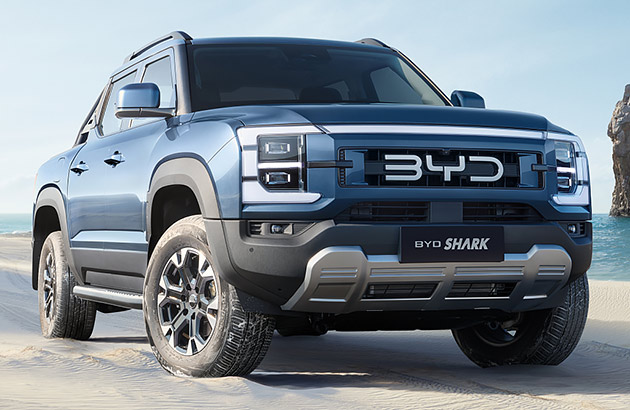
The BYD Shark 6 from China has the honour of being Australia’s first PHEV-powered ute.
Touted as an “EV-first/hybrid-second”, its specifications are impressive, costing less than many mid-grade diesel alternatives. Yet luxury and safety levels are high.
Under the bonnet is an ICE and electric motor, powering the front wheels, while a second electric motor is on the rear axle, for four-wheel drive. Providing a combined 321kW and 650Nm, BYD reckons the Shark 6 manages the 0-100km/h sprint time faster than a Ford Ranger Raptor.
Conversely, the 29.6kWh LFP battery can offer up to 100km of EV-only range; combined, this rockets up to about 800km.
The body-on-frame platform features an integrated battery pack, for strength and rigidity, as well as space efficiency: it doesn’t eat into the (spacious) cabin or (generous) load area. Suspension is a sophisticated double-wishbone arrangement.
On the flipside, payload is disappointing, as is the 200mm ground clearances. Important factors in a 4x4 ute in Australia.
| Engine: | 135kW/260Nm 1.5L turbo in-line 4 petrol/AWD |
|---|---|
| Electric motor: | 170kW/310Nm (front), 150kW/340Nm (rear) |
| Battery: | 29.6kWh Lithium iron Phosphate |
| Total power/torque: | 321kW/650Nm |
| 0-100km/h: | 5.7s |
| Fuel consumption: | 2.0-7.9L/100km |
| EV consumption: | 21.2kWh/100km |
| Electric range: | 100km |
| Combined range: | 800km |
| Payload: | 790kg |
| Towing capacity: | 2500kg |
| Safety rating: | N/A |
Plug-in hybrid electric utes coming soon
Ford Ranger PHEV
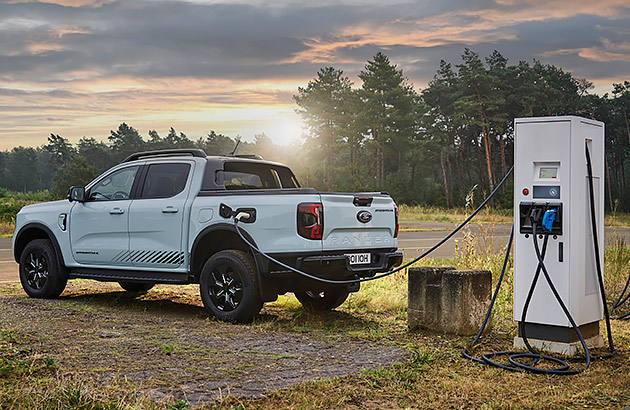
Ford will add a Ranger PHEV to Australia’s bestselling vehicle from mid-2025, to take on BYD’s pioneering Shark 6 PHEV.
Pricing and overall specification info are yet to be divulged, but we do know a turbo petrol engine and electric motor combo should provide decent if not Shark 6-style exuberant performance.
Three modes are fitted: hybrid, electric and petrol-only. An 11.8kWh battery can be replenished via a socket, recuperated braking energy, or by the engine itself. Battery size is almost one-third the BYD’s size, while pure-electric range is about half.
Ford promises that the Ranger PHEV will be “a hugely capable tool for work and off-roading”. To that end, it will include Vehicle-to-Load (V2L) ability, meaning power tools and appliances can be powered.
Off-road muscle is provided by a low-range transfer case and a locking rear differential.
At this stage, three models are coming: XLT, Sport and Wildtrak, along with a Stormtrak launch edition.
| Engine: | 2.5L turbo in-line 4 petrol/AWD |
|---|---|
| Electric motor: | N/A |
| Battery: | 11.8kWh Lithium iron Phosphate |
| Total power/torque: | N/A, 600Nm |
| 0-100km/h: | N/A |
| Fuel consumption: | 2.0L/100km |
| EV consumption: | N/A |
| Electric range: | 45km |
| Combined range: | N/A |
| Payload: | N/A |
| Towing capacity: | 3500kg |
| Safety rating: | N/A |
GWM Cannon Alpha PHEV
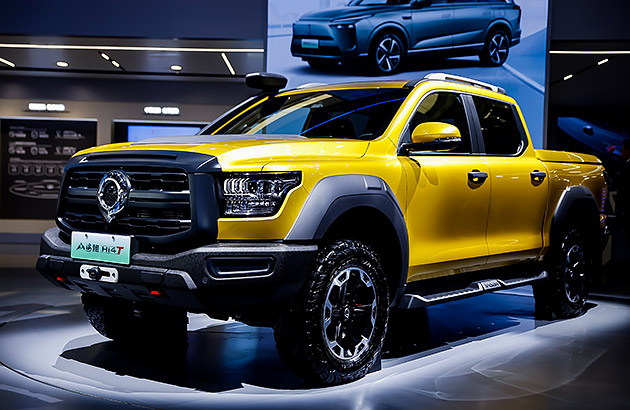
Not content with having Australia’s first hybrid ute, GWM is also poised to offer one of just three PHEV utes (after BYD Shark 6 and Ford Ranger PHEV).
With pricing and specification yet to be confirmed, expect to see the Chinese dual-cab sometime in the second half of 2024.
Based on GWM’s Hi4T platform (for Hybrid intelligence 4WD Tank), it boasts a 2.4-litre turbo petrol engine, mated to two electric motors, for a considerable 300kW and 750Nm of power and torque respectively.
A large lithium battery pack is placed towards the rear of the chassis, but its weight does diminish payload capacity. Find a 50kW DC charger, and a charge to 80 per cent requires under 30 minutes.
GWM is also proud of the Alpha PHEV’s considerable 4x4 capabilities, including 224mm of ground clearance, no loss in the HEV’s approach/departure angles and an 800mm wading depth. For power tools and appliances, it also includes vehicle-to-load capability.
| Engine: | 180kW/380Nm 2.0L turbo in-line 4 petrol/AWD |
|---|---|
| Electric motor: | 120kW/400Nm |
| Battery: | 37.1kWh Ternary Lithium |
| Total power/torque: | 300kW, 750Nm |
| 0-100km/h: | N/A |
| Fuel consumption: | N/A |
| EV consumption: | N/A |
| Electric range: | 110km |
| Combined range: | N/A |
| Payload: | 535kg |
| Towing capacity: | 3500kg |
| Safety rating: | N/A |
Hybrid electric utes
A hybrid-powered ute makes a lot of sense.
With an ICE doing the majority of the work, a small electric motor and battery can provide additional power, or take up some of the slack to help save fuel. It’s the way Toyota HEVs have worked for decades.
As a jumping-in point to electrification, this end of the market will only rise. And, as usual, China was in first.
Hybrid electric utes here now
GWM Cannon Alpha HEV from $64,990 driveaway
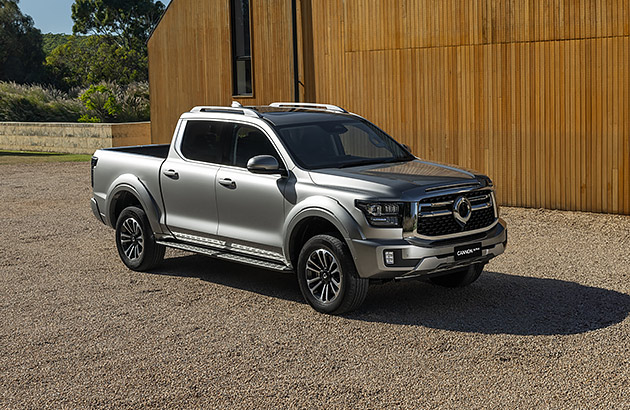
GWM broke ground with Australia’s first hybrid ute in early 2024, introducing affordable electrification for ute buyers on a budget.
Available in luxurious Ultra guise, the Cannon Alpha is slightly larger than the Ford Ranger, but not big enough to compete against the large American pick-ups like the Ram.
However, it’s worth noting that the GWM’s tub is smaller than the Ranger’s. Most of the extra space is felt inside the very SUV-like five-seater interior.
Under the bonnet is a 2.0-litre four-cylinder turbo petrol engine, paired to a nine-speed auto, driving either the rear or all four wheels as required.
Meanwhile, an electric motor and small lithium battery provide usefully extra performance and refinement, as well as reduced fuel consumption.
Despite the electrification, the Cannon Alpha HEV boasts 4x4-ready low-range gearing, approach angles and ground clearances. It also offers excellent braked towing capacity, though payload trails the best of the diesels.
| Engine: | 180kW/380Nm 2.0L turbo in-line 4 petrol/AWD |
|---|---|
| Transmission: | 9-speed auto |
| Electric motor: | 78kW/268Nm |
| Battery: | 1.76kWh Lithium |
| Total power/torque: | 255kW, 648Nm |
| 0-100km/h: | N/A |
| Fuel consumption: | 9.8L/100km |
| Payload: | 735kg |
| Towing capacity: | 3500kg |
| Safety rating: | N/A |
Electric range is quoted using the World harmonised Light vehicle Testing Procedure (WLTP), or otherwise are manufacturers’ claims.
Considering an EV? Get a discount on your car loan interest rate.
Get 0.50% p.a. off your car loan interest rate when you buy an electric vehicle.
T&Cs: Discount applies to fully electric new and used vehicles, excludes Hybrid vehicles. Offer is subject to RAC Finance Lending Terms and Conditions. Fees and charges apply. Australian Credit Licence 387972.
